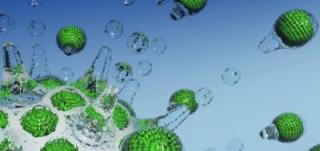Aug 20 2014
Researchers from the Institute of General Physics of the Russian Academy of Sciences, the Institute of Bioorganic Chemistry of the Russian Academy of Sciences and MIPT have made an important step towards creating medical nanorobots.
 This illustration shows nanoparcticles producing logical calculations. Credit: Maxim Nikitin
This illustration shows nanoparcticles producing logical calculations. Credit: Maxim Nikitin
They discovered a way of enabling nano- and microparticles to produce logical calculations using a variety of biochemical reactions.
Details of their research project are given in the journal Nature Nanotechnology. It is the first experimental publication by an exclusively Russian team in one of the most cited scientific magazines in many years.
The paper draws on the idea of computing using biomolecules. In electronic circuits, for instance, logical connectives use current or voltage (if there is voltage, the result is 1, if there is none, it's 0).In biochemical systems, the result can a given substance.
For example, modern bioengineering techniques allow for making a cell illuminate with different colors or even programming it to die, linking the initiation of apoptosis to the result of binary operations.
Many scientists believe logical operations inside cells or in artificial biomolecular systems to be a way of controlling biological processes and creating full-fledged micro-and nano-robots, which can, for example, deliver drugs on schedule to those tissues where they are needed.
Calculations using biomolecules inside cells, a.k.a. biocomputing, are a very promising and rapidly developing branch of science, according to the leading author of the study, Maxim Nikitin, a 2010 graduate of MIPT's Department of Biological and Medical Physics. Biocomputing uses natural cellular mechanisms. It is far more difficult, however, to do calculations outside cells, where there are no natural structures that could help carry out calculations. The new study focuses specifically on extracellular biocomputing.
The study paves the way for a number of biomedical technologies and differs significantly from previous works in biocomputing, which focus on both the outside and inside of cells. Scientists from across the globe have been researching binary operations in DNA, RNA and proteins for over a decade now, but Maxim Nikitin was the first to propose and experimentally confirm a way to implement all logical operations using nano-and microparticles, which is important not only for computing as such, but also for controlling the biomedical behavior of nanoparticles. In the future, this will allow for selective binding to a target cell and for creating a new platform to analyze blood and other biological materials.
The prefix "nano" in this case is not a fad or a mere formality. A decrease in particle size sometimes leads to drastic changes in the physical and chemical properties of a substance. The smaller the size, the greater the reactivity; very small semiconductor particles, for example, may produce fluorescent light. The new research project used nanoparticles (i.e. particles of 100 nm) and microparticles (3000 nm or 3 micrometers).
Nanoparticles were coated with a special layer, which "disintegrated" in different ways when exposed to different combinations of signals. A signal here is the interaction of nanoparticles with a particular substance. For example, to implement the logical operation "AND" a spherical nanoparticle was coated with a layer of molecules, which held a layer of spheres of a smaller diameter around it. The molecules holding the outer shell were of two types, each type reacting only to a particular signal; when in contact with two different substances small spheres separated from the surface of a nanoparticleof a larger diameter. Removing the outer layer exposed the active parts of the inner particle, and it was then able to interact with its target. Thus, the team obtained one signal in response to two signals.
For bonding nanoparticles, the researchers selected antibodies. This also distinguishes their project from a number of previous studies in biocomputing, which used DNA or RNA for logical operations. These natural proteins of the immune system have a small active region, which responds only to certain molecules; the body uses the high selectivity of antibodies to recognize and neutralize bacteria and other pathogens.
Making sure that the combination of different types of nanoparticles and antibodies makes it possible to implement various kinds of logical operations, the researchers showed that cancer cells can be specifically targeted as well. The team obtained not simply nanoparticles that can bind to certain types of cells, but particles that look for target cells when both of two different conditions are met, or when two different molecules are present or absent. This additional control may come in handy for more accurate destruction of cancer cells with minimal impact on healthy tissues and organs.
Maxim Nikitin said that although this is just as mall step towards creating efficient nanobiorobots, this area of science is very interesting and opens up great vistas for further research, if one draws an analogy between the first works in the creation of nanobiocomputers and the creation of the first diodes and transistors, which resulted in the rapid development of computer technology.